As we edge ever closer to Christmas, it feels appropriate to take a look at sweet wines. Here we consider Alsace’s top 5 sweet whites by overall Wine Lister score. Produced in a thin sliver of land in the far East of France, Alsace’s top sweet whites are separated by just nine points (less than one hundredth of Wine Lister’s 1,000-point scale!). The five wines display very similar profiles, all outperforming in the Quality category, achieiving middling Brand scores, and trailing economically.
Four break the 900-point boundary in terms of Quality scores, putting them amongst the very top quality wines on Wine Lister. Hugel et Fils Riesling Vendange Tardive (VT) falls just short with 881 points, still a very strong Quality score (thanks to 17/20 from both Jancis Robinson and Bettane+Desseauve, and 92.5/100 from Vinous). The same producer’s Gewürtzraminer VT scores even higher for quality (910) thanks to a 95/100 from Jeannie Cho Lee:
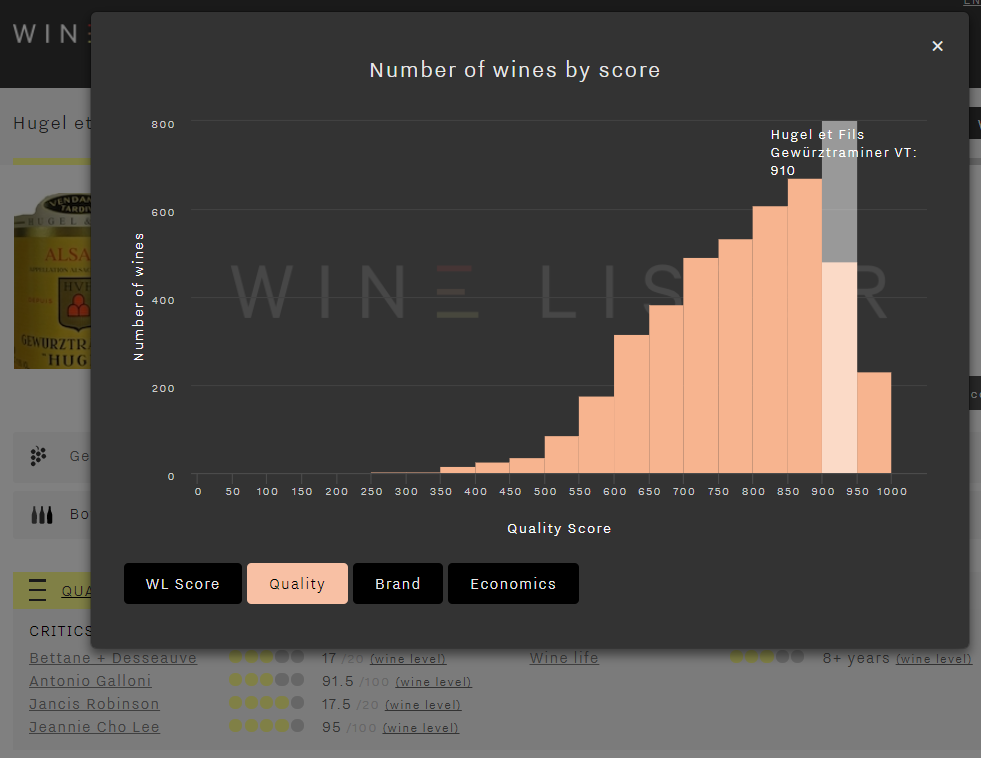
Moving categories, scores drop sharply from an average Quality score of 915 to 550 for Brand – still above the average for all wines on Wine Lister:
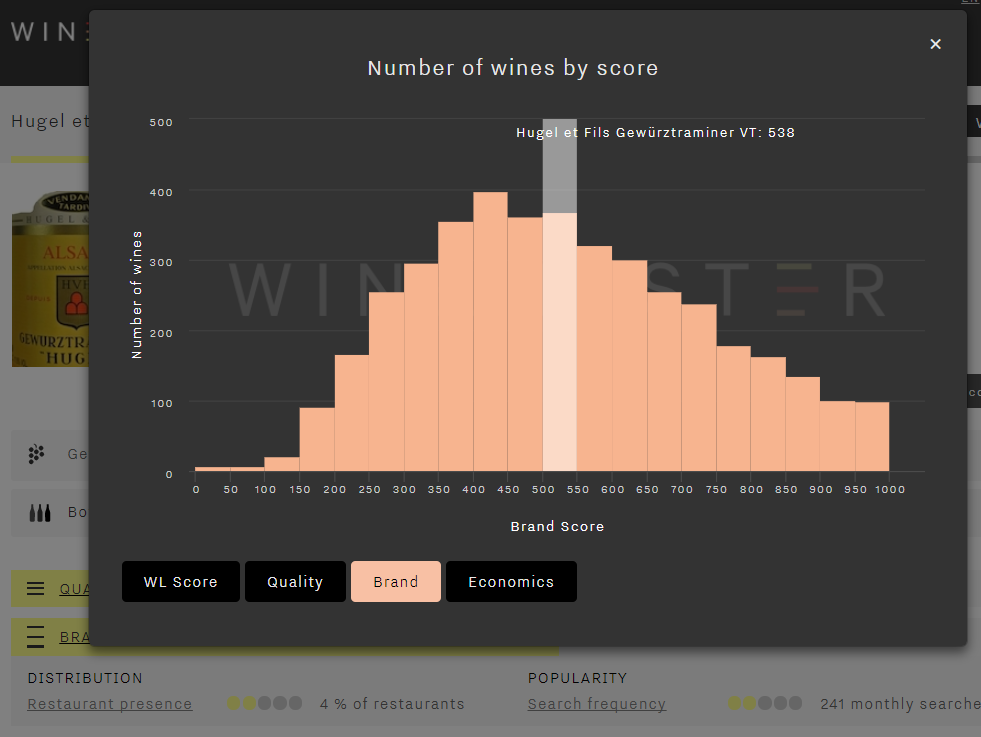
Economics scores trail even further behind, averaging 338, hindered by low liquidity. For example, Hugel’s Gewürtzraminer VT failed to trade a single bottle at auction over the past four quarters (as measured by Wine Market Journal). The chart below shows Economics score in the context of all the wines on Wine Lister – its is well below the average, with a score below 400 putting in the “weak” score band:
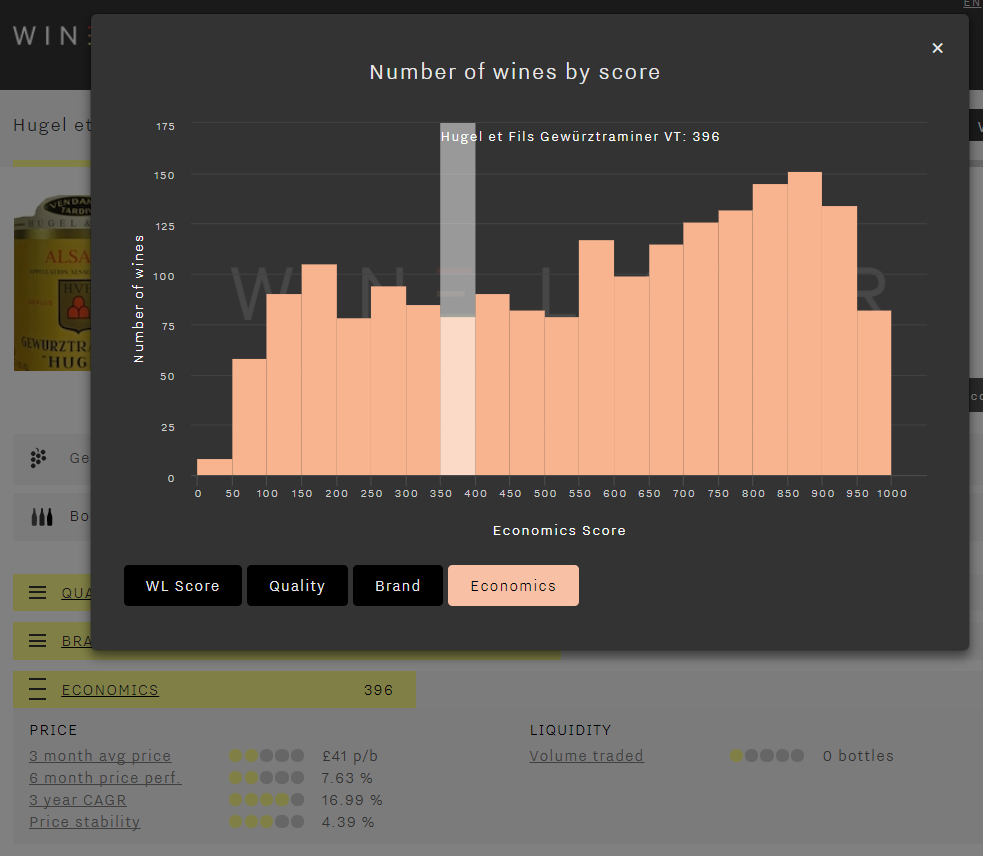
Other wines making the top five are Zind-Humbrecht Jebsal Pinot Gris VT (675) and Trimbach Gewürztraminer VT, which achieves the best restaurant presence of the group. However, featuring on just 6% of the world’s best restaurant lists, this suggests that Alsace’s sweet whites are not every sommelier’s must-list bracket, even when produced by the region’s most famous producer. Incidentally, Trimbach’s Clos Sainte Hune appears in 34% of wine lists (compared to 69% for Sauternes’ Château d’Yquem).
The last wine making it into this week’s Listed section is Marcel Deiss Altenberg de Bergheim Grand Cru. The only non-single varietal wine of the group, it is a blend of 13 different varietals planted in the same plot, and is by far Bettane+Desseauve’s preferred wine of the group – the French duo award it an average score of 19/20. It is also the most popular wine of the group. However, its modest average search frequency (380 per month on Wine-Searcher) confirms that Alsace’s sweet whites currently fly well under the radar.
So, when you’re stocking up your cellar for Christmas, give Alsace’s sweet whites a go. They might not be the most prestigious, but the quality is there and prices are pleasing.
With the recent addition of Jeannie Cho Lee MW as Wine Lister’s fourth partner critic, now seems a good opportunity to elucidate our approach to calculating Quality scores.
Wine Lister’s Quality scoring algorithm takes into account each critic’s rating scale and the relative generosity or severity of their scoring.
Vinous and Jeannie Cho Lee rate on a 100-point scale, whereas Jancis Robinson and Bettane+Desseauve rate on a 20-point scale. But we also know that the former pair never (or very rarely) give a rating less than 70, while the latter never (or very rarely) give a rating less than 10.
The first step in our scoring algorithm is to put all ratings on a level playing field by rebasing them. We take each critic’s minimum and maximum wine ratings and spread these back out over our entire 100-point scale. The result is that, for example, a Bettane+Desseauve rating of 15 and a Jeannie Cho Lee rating of 85 both score 50 out of 100.
But it’s not quite that simple! We also know that the way the critics score is different. For example, we find that Jeannie Cho Lee tends to give fewer high scores than Vinous. Our algorithm takes into consideration these tendencies towards more or less generous ratings, and adjusts scores as necessary for a fair outcome. This is our score normalisation process.
Using nonparametric statistical techniques, for the same wine-vintages that the critics have rated, we look at each critic’s probability of awarding each score, and use the difference in probabilities to make necessary adjustments.
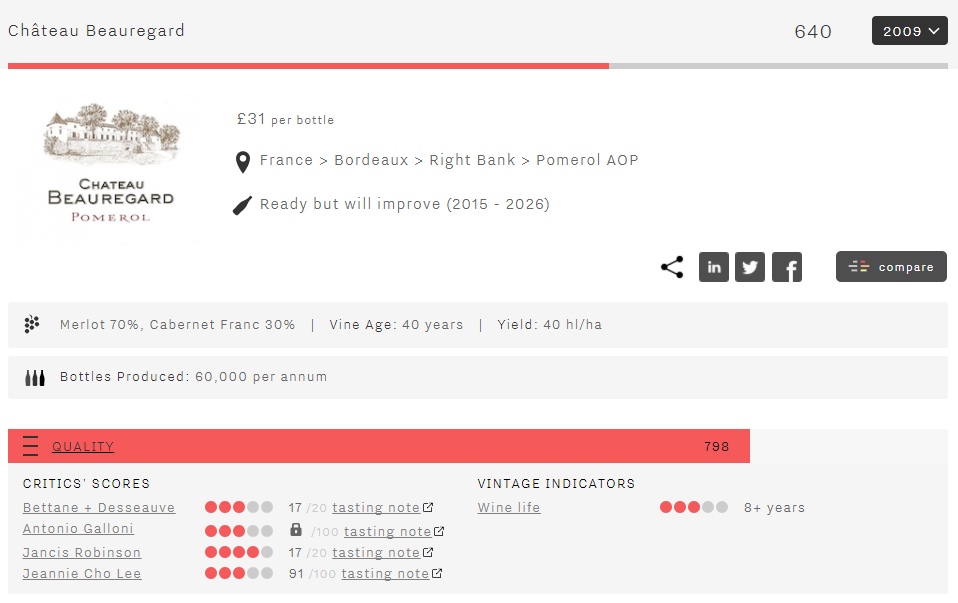
For example, we looked at the set of wine-vintages rated by both Jancis Robinson and Bettane+Desseauve, and found that wines are around 5% more likely to achieve a rating of 17 or higher from Bettane+Desseauve. Once normalised, this means that a wine such as Château Beauregard 2009, rated 17 by both Bettane+Desseauve and Jancis Robinson, achieves Wine Lister critic scores of 73 and 76 respectively. In other words, 17 is harder to get from Jancis Robinson than from Bettane+Desseauve. This is illustrated in the image above.
Once we’ve rebased and normalised the critics’ scores, we simply take an average of those scores, giving an equal rating to each of our four partner critics, each of whom represents one of the world’s key fine wine markets.
There’s still more… The Wine Lister Quality score also takes into consideration a wine’s ageing potential as defined by critics’ drinking windows – watch this space for a further explanation of how that works!
Certain wines are a safer store of value than others. One of our four Wine Lister Indicators – Investment Staples – enables you to spot these instantly. The bespoke algorithm identifies wines of a high quality level, long-lived and not too old, above a certain price (therefore soaking up the frictional costs of collecting wine), with proven price performance, stability, and liquidity.
This last criterion is measured using the number of bottles traded at wine auctions globally. With the latest quarterly data in from Wine Market Journal, 16 new wine and vintage combinations (across nine producers) have recently become Investment Staples. These wines are all over £50 a bottle, with the majority falling under £400, but the most expensive – Roumier’s 2013 Musigny – costing £4,851.
Several of the new Investment Staples have displayed an upward price trend over the last six months, in particular Leroy’s Vosne-Romanée Aux Brûlées 2013 and Roumier’s 2008 Musigny, both of which have seen increases upwards of 30%.
Wine investment is not often associated with white wines, but six of the new Investment Staples are just that. All possess staying power, and are young enough to have room for improvement. What is more, they are made by some of the finest wine producers there are, allowing them to challenge some of their red neighbours in terms of investment fundamentals. Of these, Roulot’s Meursault Charmes 2012 has the best six-month price performance, plus one of the longest drinking windows based on the average assessment of our partner critics. Jean-Marc Roulot has been a rising star for several years now, but his wines are still in the ascendancy.
The new Investment Staples nearly all hail from Burgundy, with just a handful of entries from Piedmont and the Rhône. Those seeking something a bit different that still possesses the criteria of a solid investment might look to Italian white, Gaia & Rey 2012 from Gaja, which has a drinking window of 2015-2025, 6.3% six-month price performance, and price tag of £124.
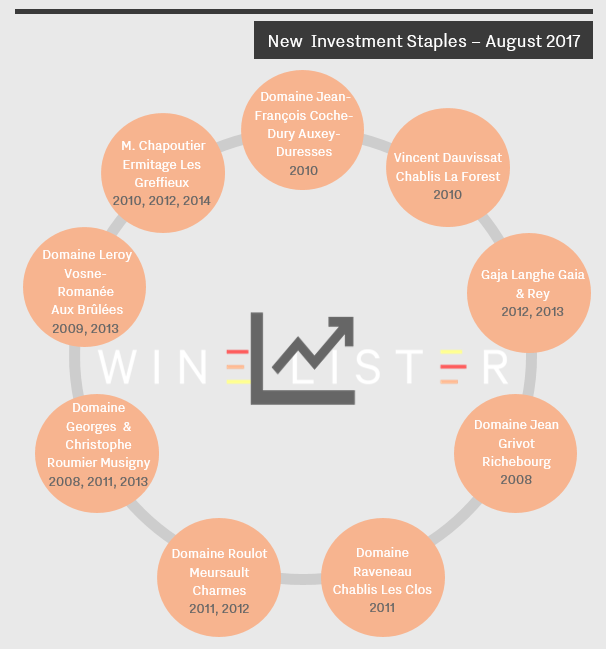
To search for more Investment Staples, subscribers can click here, filtering by country, region, type, style, price, and score, to drill down exactly into what wine you’re after.
In today’s blog, we’ve taken a look at the relationship between price and quality for seven leading wine regions. The chart below compares the regions’ average three-month market prices to their Quality scores, with the data calculated from each region’s 50 best-scoring wines (in terms of overall Wine Lister score).
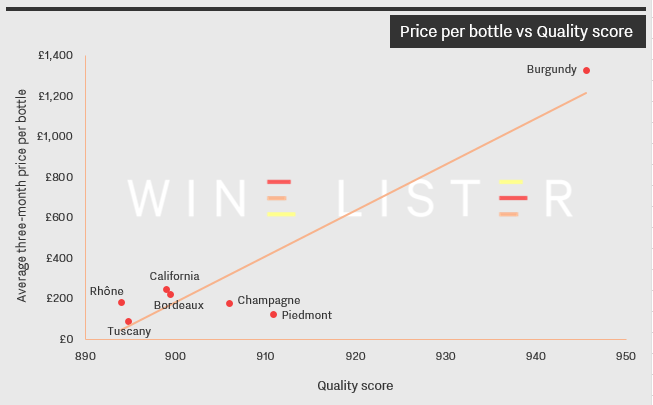
While six regions are clustered relatively close to each other, Burgundy finds itself at the extreme top end of the scale: its wines outperform on quality and have the prices to match. The top 50-scoring wines in Burgundy average a whopping £1,330 per bottle, driven by the likes of DRC La Romanée-Conti at £10,776 and Domaine Leroy Musigny at £7,805.
The Rhône’s wines have the lowest average Quality score but not the lowest prices: at £188 per bottle on average, they are the fourth most expensive of the group. California and Bordeaux display a very similar profile, appearing just above the trendline, indicating that these wines command high prices not simply on account of quality – brand also plays a part.
Champagne and Piedmont, meanwhile, fall below the line, suggesting that as regions they tend to offer value for money. Piedmont’s ranking is particularly impressive: second only to Burgundy in terms of average Quality score, its wines are available for a tenth of the price on average.
Wine Lister’s UK partner critic Jancis Robinson has released her scores for Bordeaux 2016 over a series of tasting articles, and these can now be found on Wine Lister’s individual wine pages.
While 2016 has been hailed by some as a left bank vintage, Robinson found much to enjoy across both sides of the Gironde. In Pomerol, she praised “those who waited and managed the difficult business of judging picking times correctly”, and more 19-point wines came from this appellation than any other. She singled out Vieux Château Certan 2016 for setting “the standard for the appellation” and noted its “lovely ripeness and nobility.” In Saint-Emilion, 19-point Figeac 2016 was “Zesty and confident and of the place”, while Canon 2016 had “real lift and drive.”
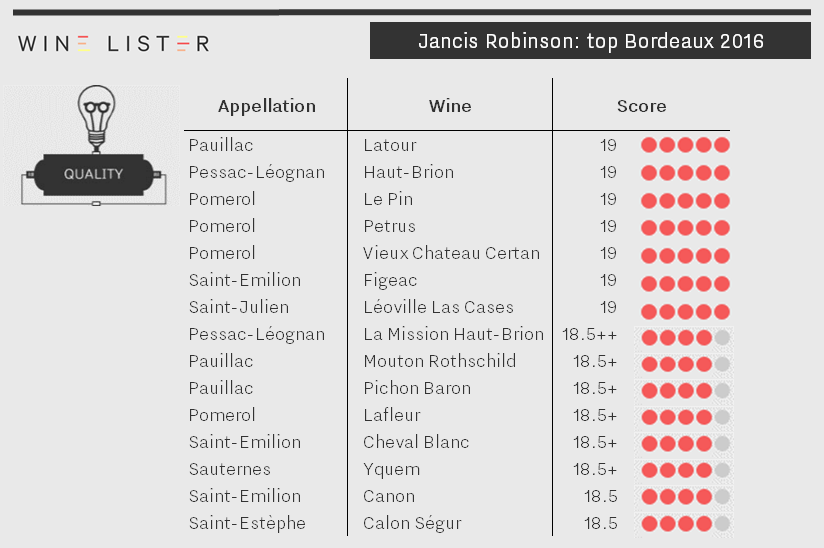
On the left bank, three of the first growths were among Robinson’s top scorers. As Wine Lister has already noted, 2016 was a tricky growing season, and Robinson reports that at Haut-Brion, Jean-Philippe Delmas “pointed out that the vintage was saved by the cool nights that retained the grapes’ and therefore wines’ freshness.”
From Pauillac, Latour 2016 significantly had “much more finesse than traditional Latour”, while Robinson described Mouton Rothschild 2016 as “bone dry and utterly embryonic compared with most of the 2016s (with the notable exception of Las Cases).” Léoville Las Cases 2016 also received 19 points from Robinson.
Notably, amongst Robinson’s top scorers there are no dry whites – a category she described as “the least exciting section of the Bordeaux 2016 vintage” – and only one sweet white (Yquem 2016), a group for which Bordeaux 2016 “won’t go down in history.”
As we know, the quality of a wine is not set in stone. Just like our Brand and Economics scores, Wine Lister’s Quality scores are also updated over time as wines evolve and new vintages are released.
Our algorithm analyses Quality by aggregating ratings from our three partner critics: Jancis Robinson, Bettane+Desseauve and Vinous (Antonio Galloni). It also comprises a small weighting for a wine’s longevity, based on the critics’ combined drinking windows, with the drink-by date updated regularly as our partner critics retaste and reevaluate.
In this post we look at the 10 biggest gainers in Quality over the course of 2016:
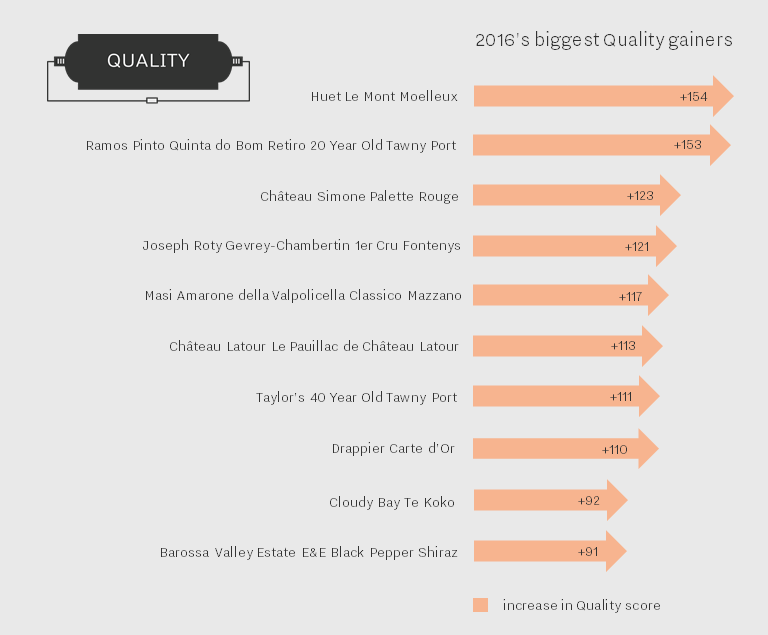
Huet’s Le Mont Moelleux improved the most last year, adding over 20% to its score, taking it to 917. This is down to a score of 18/20 for the 2015 vintage from our UK partner critic JancisRobinson.com.
Also partly thanks to a new score of 18 from the same critic, in second place is the fortified Ramos Pinto Quinta do Bom Retiro 20 Year Old Tawny Port. The wine was also deemed to be eight years longer-lived than had been previously thought, contributing considerably to its Quality score surge.
Château Simone’s Palette Rouge received a higher-than-average score from Bettane+Desseauve for its 2012 vintage, making it the third-highest gainer for the year.
Improvements were also enjoyed across a wide range of other regions, from Bordeaux to Champagne, and in the New World.
Who will be 2017’s biggest Quality gainers? Only time (and tastings) will tell.
The Wine Lister Brand score algorithm has two components: Distribution and Popularity. The former criterion measures a wine’s presence in the world’s top restaurant wine lists. The latter measures the number of searches for each wine on the world’s most visited wine website Wine-Searcher, our Popularity Partner. We look at the number of times the wine is searched for over a rolling three-month period, and compare this to search frequencies of all other wines. The higher the relative search frequency, the higher the Popularity score.
Our latest score update includes updated Wine-Searcher data for October. The chart below shows the impact of new search data on Brand scores, showing the five biggest gainers:
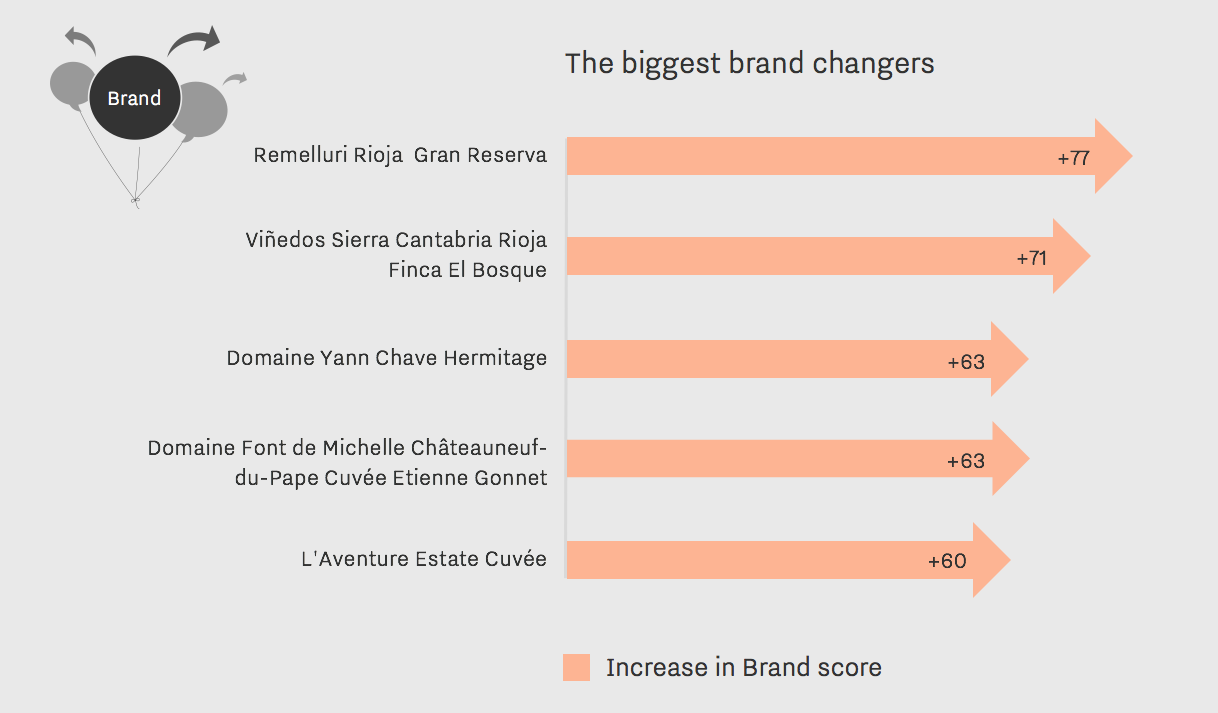
Rioja and the Rhône come out top. The largest gain in Brand score is for Remelluri Rioja Gran Reserva which has seen a considerable surge in user searches (322 monthly searches compared to 172 before the update), as has fellow Rioja, Viñedos Sierra Cantabria Finca El Bosque. In third and fourth place are two wines from the Rhône Valley: Domaine Yann Chave Hermitage and Domaine Font de Michelle Châteauneuf-du-Pape Cuvée Etienne Gonnet. The fifth biggest gainer in Brand terms is Californian adventurer, L’Aventure Estate Cuvée.








